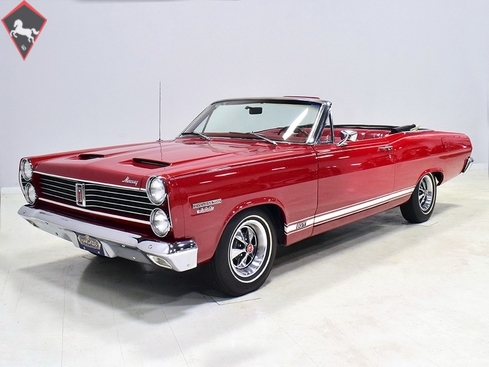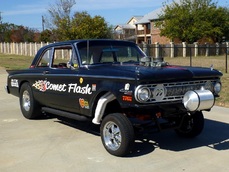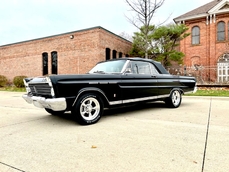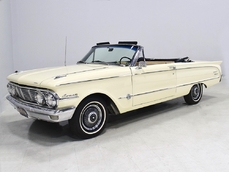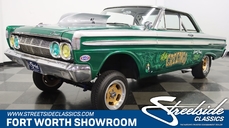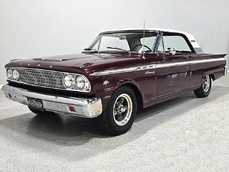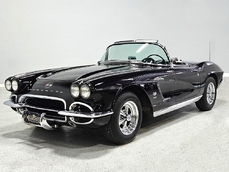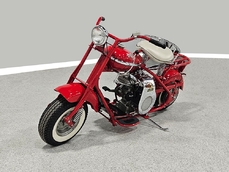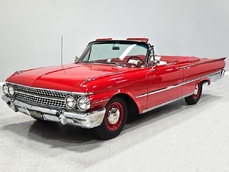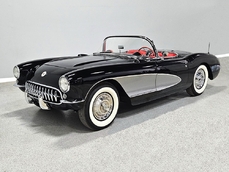Mercury Comet 390 cubic inch V8 1967
General description :
The name might be a bit cumbersome—Mercury Comet Cyclone GT convertible—but the car is flat-out incredible. In 1966 the Comet moved up a size and was now a cousin to the mid-sized Fairlane rather than the compact Falcon. This, of course, had the side benefit of allowing big block V8s to easily fit under the hood, which was surely the point. Mercury needed some flash in the showroom and the Cyclone GT delivered in a big way. The GT was more a competitor for the Olds 442 and Buick GS, bringing big power with a softer edge and a more upscale personality—make no mistake, this was an expensive car. But despite serious performance and those handsome good looks, only 378 GT convertibles were built in 1967 and this might just be the best of them all. It offers incredible preservation, a known history back to new, a California pedigree, and a great story. What else could you want from a collector car?
This phenomenally well-preserved 1967 Mercury Comet Cyclone GT convertible has had just two owners from new and spent the first 45 years of its life in sunny California. The original owner was a judge in California who apparently won it from a Mercury dealer in a poker game—the car was the centerpiece of the dealer’s showroom, sitting in a roped-off display area for most of the 1967 model year, waiting for just the right buyer to come along. But as things go, the dealer came up a little short so the Cyclone plus a little cash settled the debt a few days before Christmas 1967. The judge kept the car for decades, maintaining it in excellent condition and using that original dealer for service for most of its life. That kind of care has rendered this car one of the finest survivors we’ve ever seen. There are a few areas of touch-up on the body, most notably the trunk lid which isn’t quite the same color, but most of the paint is original, including the wonderfully preserved fiberglass hood. Even the white pinstripes and GT stripes along the rockers are original paint, not decals. As a California car, there’s no sign of rust or rot anywhere on the car (check out that undercarriage!) and the laser-straight bodywork stands up to scrutiny form any angle. As we said, this is one of the most impressive unrestored cars we’ve ever seen.
The code 8D red vinyl bucket seat interior is almost entirely original. Seats, door panels, dash pad, and console all date to 1967, and even the carpets are original. Yeah, no kidding. The Cyclone GT got a full set of instruments in four round pods ahead of the driver, and they’re fully operational including the factory tach. Look at the bright, crisp markings on the gauge faces, the bright chrome strips on the dash, and the unmarked center console. The seats are still firm and comfortable, all the interior lights work, and even the little indicator lights in the shifter glow brightly. There’s a newer white power convertible top overhead and there’s a brand new red vinyl boot that is still in the original wrapper, so we didn’t want to open it. The fully finished trunk uses a replacement mat set, but that is the original spare tire and factory jack assembly and there’s plenty of evidence of its California life underneath.
The engine is the car’s original S-code 390 cubic inch V8, which was standard in the GT. It makes a rather stout 335 horsepower and 427 pounds of torque, turning the Cyclone into a rather serious performance car when you stand on the pedal. Despite just 65,278 original miles, it was fully rebuilt and detailed last year. You'll note it still carries all its original California emissions equipment, including the AIR pump and EGR crossover, both of which are probably unobtainium today and it’s all operational. Detailing is well done and with Ford blue and a few splashes of chrome, it's a very attractive engine bay that you’ll want to show off at events. The big 390 starts right up, and while it's a little grumpy for the first minute or so while it’s on the choke, it smooths out after that and pulls like a freight train. There's torque all over the tach and you never have to rev it very hard, which is why I think the C6 3-speed automatic transmission is a better choice—there’s still a bit of luxury car DNA in this muscular Merc.
Believe it or not, the undercarriage is original—it has been carefully cleaned and clear-coated for protection, but the finishes and condition are mostly factory-issue. It's a fantastic example for benchmarking these cars, proving that red oxide primer on the floors isn't necessarily correct. Power steering and power front disc brakes make it extremely easy for anyone to handle and the beefy C6 3-speed automatic transmission doesn’t seem to notice all the torque churning through it. Note details like the original spot welds and even paint drips on the rockers, immaculate torque boxes, factory markings on the driveshaft, and a reproduction dual exhaust system that sounds just right. The major systems have all been serviced and/or rebuilt so it drives beautifully and there are 3.25 gears out back making it a fantastic highway cruiser. Styled steel wheels with correct F70-14 Firestone whitewalls complete the look.
As a result of having just two long-term owners, this Comet comes with an extensive paper trail documenting the care it has received over the years. Factory papers include the original build sheet, window sticker, original OwnerCard, factory owner’s manual, body tags, and more. It also comes with decades of registration documents, its original California black plates, and receipts for service dating back more than 40 years, which authenticates the mileage. A standard Marti Report and a framed Deluxe Marti Report are both included, confirming the car’s specifications and rarity, as well as the fact that it was delivered new to Fresno, California.
After spending time in the driver's seats of more than 1000 old cars over the past five years, I can say unequivocally that we've only had a handful that were this good. It's not quite original enough to be called a survivor, but it's not restored, either, which is probably why it feels so right. It has been carefully maintained and restored as needed and obviously cost was no object. It is exceptionally rare and I would put it on par with an L34 396/350 Chevelle SS, which could easily cost more and is more common to boot. This is a remarkable car, but it'll take a remarkable guy to see the forest for the trees. If you're that guy, give us a call and let's get this amazing Merc into your garage.
Harwood Motors welcomes and encourages personal or professional inspections of any vehicle prior to purchase.
http://www.harwoodmotors.com/vehicles/inventory_details.php?id=1106
1967 Mercury Comet 390 cubic inch V8 is listed sold on ClassicDigest in Macedonia by for $54900.
Car Facts
Car type : Car Make : Mercury Model : Comet Model Version : 390 cubic inch V8 Engine size : 0.0 Model Year : 1967 Sub type : Convertible Location : Ohio
Sold
Seller Information
Sold
People who viewed this Mercury Comet also viewed similar Mercury listed at ClassicDigest
Other cars listed for sale by this dealer
About Mercury
Mercury, the automotive brand, has a rich history that extends beyond its role in the customization and hot-rodding scene, particularly with the iconic Mercury Eight. Here are some key points to know about Mercury:Formation and Early Years:
Mercury was introduced by the Ford Motor Company in 1938 as a mid-priced brand, positioned between the affordable Ford models and the luxury Lincoln lineup. The brand aimed to fill the gap between these two segments.
Mercury Eight:
The Mercury Eight, launched in 1939, is perhaps the most famous model in the brand's history. It featured a sleek design and a powerful V8 engine. This model became popular for customization and hot-rodding, earning it a significant place in American automotive culture.
Customization Culture:
The Mercury Eight, with its distinctive styling and relatively affordable price, became a favorite among custom car builders. It played a pivotal role in the development of the custom car and hot rod culture, particularly in the post-World War II era.
Lead Sleds and Customization:
The term "lead sled" is often associated with heavily customized cars from the 1940s and 1950s. These cars, including the Mercury Eight, were often modified with lowered suspensions, chopped roofs, and other stylistic changes. Lead sleds were a prominent part of the custom car scene, and the Mercury Eight was a popular choice for such modifications.
Post-War Prosperity:
In the post-World War II period, Mercury, like many other American automakers, experienced a surge in popularity as the economy boomed. The brand contributed to the era's fascination with stylish and powerful automobiles.
Evolution of Models:
Over the years, Mercury continued to produce various models, contributing to Ford's lineup. Some notable models include the Mercury Monterey, Mercury Comet, and Mercury Cougar.
Decline and Discontinuation:
Despite periods of success, Mercury faced challenges in establishing a unique identity separate from Ford. As consumer preferences shifted, the brand struggled, and Ford eventually announced the discontinuation of Mercury in 2010.
Legacy in Popular Culture:
Mercury, especially models like the Mercury Eight, holds a significant place in American popular culture. Its association with the customization and hot-rodding scene, as well as its distinctive designs, has left a lasting impact.
In summary, while the Mercury Eight is celebrated for its role in the customization and hot-rodding subculture, Mercury as a brand played a broader role in automotive history, contributing to mid-priced segments and reflecting the automotive trends of its time.
